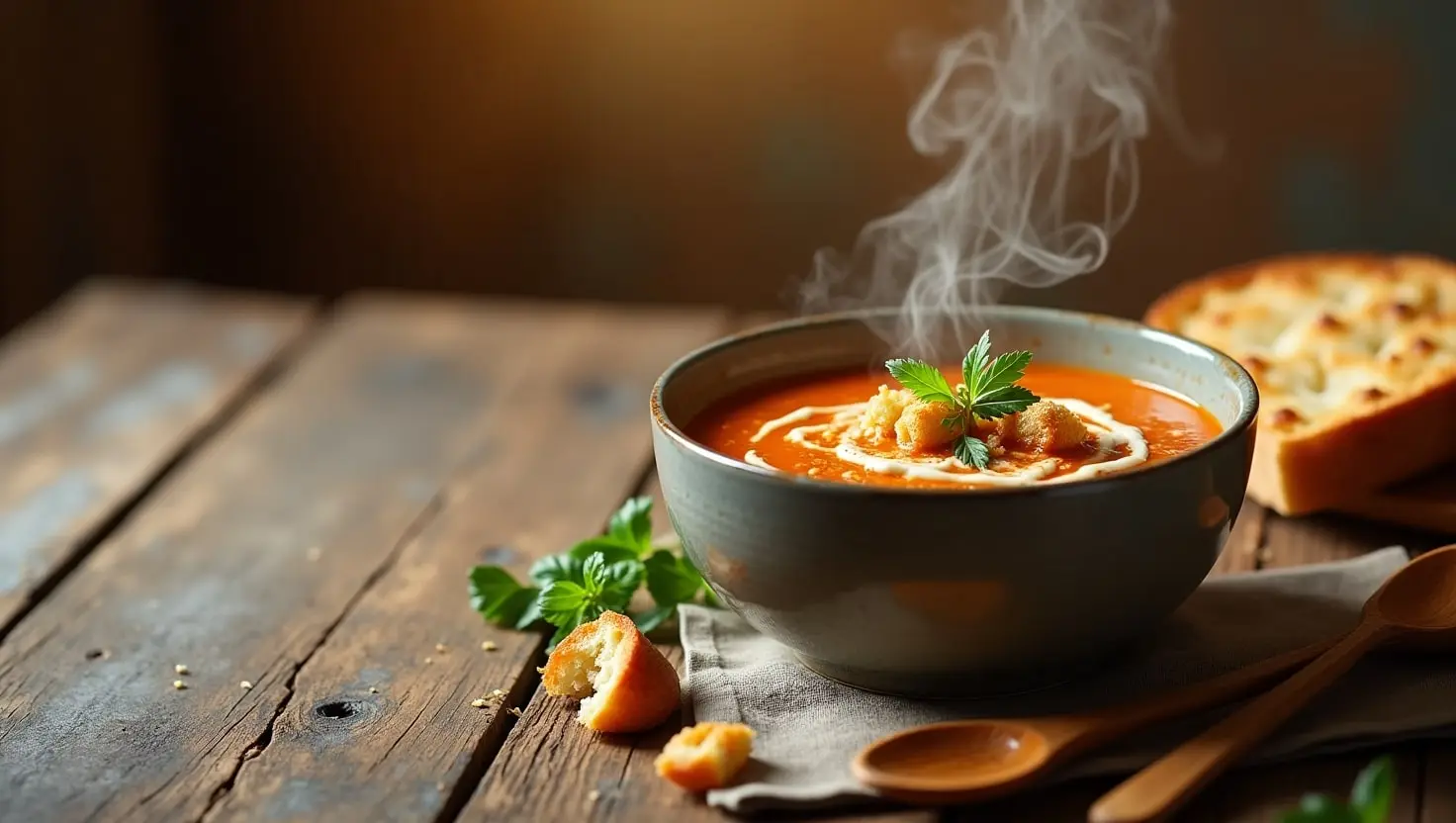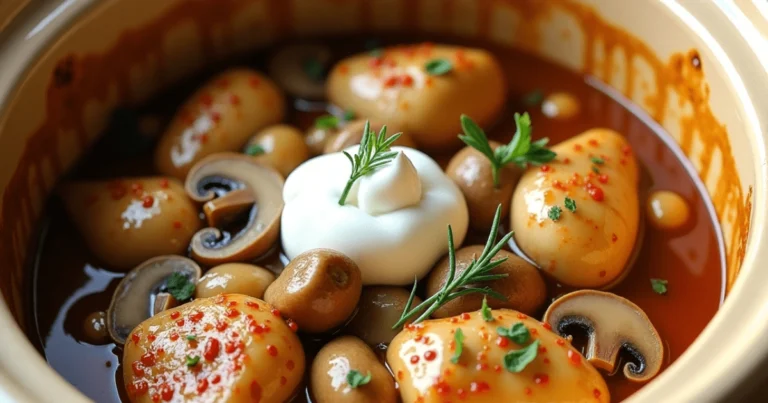10 Genius Ways to Make Canned Soup Taste Like Homemade in Minutes!
A Warm Bowl, A Cold Day – The Power of Comfort Food
You know that feeling — it’s raining outside, you’re wrapped in your coziest blanket, and all you want is a warm bowl of something comforting. Canned soup seems like the easiest fix. It’s quick, cheap, and waiting in your pantry for nights like this. But then you crack it open, pour it in a pot, take a bite… and it’s just okay. Thin. Bland. Kinda metallic, even.
Don’t worry — you’re not stuck with a sad soup. With a few genius upgrades, you can turn that boring can into something that tastes like it came out of Grandma’s kitchen.

Why Canned Soup Needs a Little Help
Let’s be real. Most canned soups are designed for convenience, not flavor. They’re loaded with sodium and preservatives to stay shelf-stable for months (sometimes years), and the textures are often mushy or watery.
Here’s what’s typically lacking in canned soup:
- Flavor depth – It often tastes flat.
- Freshness – Overcooked ingredients, limp veggies.
- Texture – No crunch, no chew, no contrast.
- Customizability – It’s a one-size-fits-all meal.
But the good news? You can fix all of that. And fast.
1. Sauté Aromatics First
Garlic, Onion & Celery Are Flavor Bombs
Before you even pour the soup into the pot, take a second to heat some olive oil or butter and sauté chopped onions, garlic, or celery (or all three). These basic aromatics instantly boost the flavor foundation.
Why this works:
You’re layering flavors from the very start. Canned soup usually skips this step to save costs.
Quick tip:
Cook them for 3–4 minutes on medium heat, just until fragrant and golden. Then pour your soup in.
2. Add Fresh Herbs or Dried Spices
Transform It With Thyme, Basil, Oregano, or Cilantro
Spices are secret weapons. A pinch of dried oregano, thyme, smoked paprika, or even chili flakes can completely change the game.
Want something extra fresh? Chop up parsley, basil, or cilantro and sprinkle it on top right before serving.
Timing matters:
- Add dried herbs while the soup simmers so they release their oils.
- Use fresh herbs at the end for a flavor punch.
3. Use Stock Instead of Water
Chicken, Veggie, or Bone Broth for More Depth
If your canned soup calls for adding water (like condensed soups), don’t. Use stock or broth instead.
Even if it’s not required, you can stretch the soup a bit with broth to tone down saltiness while adding richness.
Try:
- Chicken broth for chicken noodle
- Veggie broth for lentil or tomato soups
- Bone broth for extra protein and collagen
4. Stir in Protein for Hearty Goodness
Shredded Chicken, Beans, or Tofu Add Substance
Most canned soups are pretty light on protein. Bulk it up by tossing in:
- Leftover rotisserie chicken
- A can of white beans or chickpeas
- Cubed tofu for a vegan twist
- Cooked shrimp or ground beef (why not?)
This not only makes the soup heartier, but also more filling and satisfying.
5. Drop in Fresh or Frozen Veggies
Spinach, Corn, Peas, Carrots – Add Some Color!
A can of soup might have a few sad carrot cubes floating around, but it’s nothing compared to fresh or frozen veggies.
What you can add:
- Fresh spinach or kale (add last)
- Frozen peas or corn (add with 5 mins left)
- Chopped bell peppers, mushrooms, or zucchini
These ingredients add crunch, color, nutrients — and let’s face it — life.
6. Add a Creamy Touch
Coconut Milk, Cream, or Greek Yogurt Elevates Flavor
If your soup feels thin, try adding a creamy element to thicken and enrich the texture.
Try this:
- A swirl of heavy cream
- A dollop of Greek yogurt (cool slightly before adding)
- A splash of coconut milk (great for spicy or veggie soups)
This little touch transforms the soup into something velvety and indulgent.
7. Add Acid for Brightness
Lemon Juice, Vinegar, or Tomato Paste Balances Flavors
You know that feeling when a dish is almost there but something’s missing? It’s probably acid.
Acid wakes up the flavor in your soup. It adds a tangy, sharp contrast that balances richness or saltiness.
Best acidic options:
- Lemon or lime juice
- Apple cider vinegar
- A spoon of tomato paste (adds both tang and umami)
Just a splash or squeeze before serving is all it takes.
8. Toss in Cooked Grains or Pasta
Rice, Quinoa, Noodles – Use What’s in Your Pantry
Canned soups often don’t give you much to chew on. That’s where carbs come in.
Have leftover rice, cooked pasta, or grains? Stir them in and make the soup a real meal.
Examples:
- Chicken soup + rice = chicken rice soup
- Tomato soup + elbow macaroni = homemade tomato mac
- Lentil soup + quinoa = plant-based power bowl
9. Top It Off Creatively
Croutons, Cheese, Herbs, Chili Oil Add Wow-Factor
Never underestimate the power of toppings.
Some easy, flavorful options:
- Toasted croutons for crunch
- Grated Parmesan or cheddar
- Fresh chopped parsley or scallions
- Drizzle of chili oil or olive oil
They’re simple but give your soup that chef-style finish.
10. Simmer Low and Slow (Even for 5–10 Mins)
Let the Flavors Mingle
After you add your upgrades, don’t rush to eat it. Let your soup simmer for 5–10 minutes. That gives the spices time to bloom and the ingredients a chance to marry together.
Don’t boil — just let it bubble gently on low. Stir occasionally and let the magic happen.
Example Recipe Table – Tomato Soup Glow-Up
| Ingredient | Quantity | Step |
|---|---|---|
| Canned Tomato Soup | 1 can | Base |
| Olive Oil | 1 tbsp | For sauté |
| Garlic (minced) | 2 cloves | Sauté until fragrant |
| Onion (chopped) | ½ small | Add to sauté |
| Dried Basil | ½ tsp | Stir in while cooking |
| Cream | ¼ cup | Add after soup heats |
| Spinach (fresh/frozen) | ½ cup | Stir in before serving |
| Lemon Juice | 1 tsp | Squeeze at the end |
| Parmesan & Croutons | Optional | Top for final touch |

Final Tips for Canned Soup Mastery
Before you start upgrading, taste your soup. Some canned versions are already salted to the moon and back, so go easy when adding salt or cheese.
Start small — you don’t need to do all 10 genius tricks every time. Mix and match based on what you have.
And remember, you’re not just making soup — you’re turning pantry basics into cozy, crave-worthy meals. That’s real kitchen magic.
Table of Contents
Conclusion: From Can to Comfort in 10 Minutes Flat
Who knew that something as basic as canned soup could turn into a restaurant-worthy dish with just a few tweaks? The secret lies in layering flavor, adding texture, and not being afraid to experiment.
You don’t need culinary school or a fancy pantry. Just a few fresh ingredients, a little heat, and some creativity.
So next time you’re reaching for that dusty can in your cupboard — smile. You’ve got 10 genius ways to make it amazing.
FAQs – Canned Soup Hacks
1. What are the healthiest canned soups to use?
Go for low-sodium, high-fiber, and protein-packed options. Look at the ingredient list — fewer ingredients usually mean fewer chemicals.
2. Can I make canned soup taste like it’s from a restaurant?
Yes, easily! Add cream, toppings, or proteins, and use aromatics to mimic restaurant depth.
3. Is it safe to add raw veggies or meat into canned soup?
Raw veggies? Yes. Raw meat? No. Pre-cook your meats to avoid food safety risks.
4. Can I freeze canned soup after upgrading it?
Totally. Let it cool, portion it, and store it in freezer-safe containers. Lasts up to 2–3 months.
5. What should I avoid adding to canned soup?
Avoid raw flour (makes it clumpy), excessive salt, and super bold spices that can overpower the base flavor.
Please don’t forget to leave a review.







